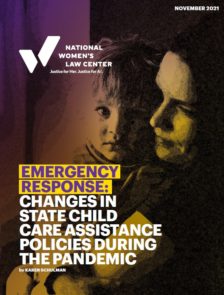Abortion rights, women of color, and LGBTQI+ people are under attack. Pledge to join us in fighting for gender justice.
 COVID profoundly destabilized the already tenuous child care sector. During the early months of the pandemic, many child care programs were forced to close under state health and safety mandates. Programs that remained open or reopened during the crisis struggled with new health and safety protocols that increased costs. Many programs also saw a drop in enrollment as some parents had concerns about safety, and other parents decided not to use child care while they were working from home or unemployed. As a result, child care programs, which already had very tight margins prior to the pandemic, have experienced even more intense financial pressures during the pandemic.
COVID profoundly destabilized the already tenuous child care sector. During the early months of the pandemic, many child care programs were forced to close under state health and safety mandates. Programs that remained open or reopened during the crisis struggled with new health and safety protocols that increased costs. Many programs also saw a drop in enrollment as some parents had concerns about safety, and other parents decided not to use child care while they were working from home or unemployed. As a result, child care programs, which already had very tight margins prior to the pandemic, have experienced even more intense financial pressures during the pandemic.
New federal—and in some cases, state—funding for child care, together with federal guidance that allowed and even encouraged state action, made it possible for states to adopt and revise child care assistance policies to help families and providers weather the crisis. This report examines policy changes that states made in response to the pandemic in six key areas. The report’s findings demonstrate that every state made temporary changes in one or more of these policy areas in response to the pandemic.
- Income eligibility limits for child care assistance
- Copayments required of families receiving child care assistance
- Eligibility for child care assistance while parents search for a job
- Payment rates for providers serving families receiving child care assistance
- Payment to child care providers for days when children are absent from care
- Payment for school-age care
These changes were intended to make it easier for families to access and retain child care assistance, reduce families’ child care cost burdens, offer more reliable income for child care providers, and help cover providers’ additional costs during the pandemic.

